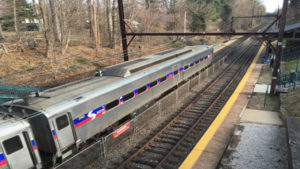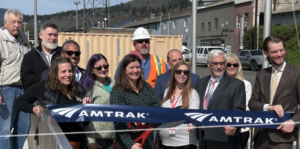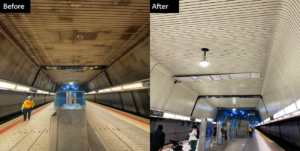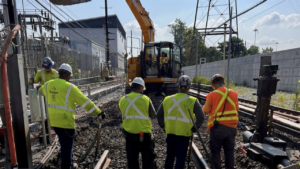Methods that make the cut
Written by Jenifer Nunez, assistant editor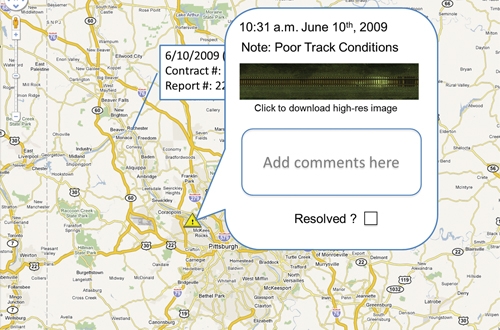
Suppliers are producing machines and developing methods to tackle unwanted vegetation. Weeds, plants and other undergrowth are Mother Nature’s little annoyances to the railroads. Vegetation management crews are constantly out on-track, off-track and now even up in the air, fighting the battle for a clear right-of-way. There have been many improvements in herbicide mixes and machines to help keep ground bare, including a new system called Chlorovision. ARS One challenge in particular for vegetation management crews is fighting for track time to get the job done, that’s why All Railroad Services Corp. takes the work off-track. Vinnie Vaccarello, co-president of ARS Corp., notes that the company is consistently asked to find ways to do vegetation control off-track, since track time is always a premium. To aid in the time constraint battle, ARS Corp. looks to incorporate vegetation control in other services it provides to maximize track time. Vaccarello says railroads defer vegetation management and it gets out of control; however, railroads are starting to learn that an aggressive maintenance program saves money in the long run. Asplundh Asplundh Railroad Division now offers its Aerial Tree Trimmer, an airborne trimmer, which does not require track time to perform trimming operations. It’s capable of working in rugged or swampy areas where ground crews have limited access to the right-of-way. Heavy overhanging brush is easily removed by the 10-blade saw cluster, leaving a ground to sky view. The Aerial Trimmer is also capable of providing chemical side trimming. The company is currently working with Perceptive Robotics to develop a system called Chlorovision, which is currently in use. Using new vegetation identification technology, the Chlorovision system identifies vegetation in the treatment zone with pinpoint accuracy and automatically controls the application equipment to precisely treat only the targeted vegetation at speeds up to 50 mph. To learn more about Cholorovision, please see page 26. Boatright Drift control is and always will be a major concern for railroad vegetation control applicator companies, notes Shane Boatright, president of Boatright Companies. “It can have a tremendous impact on your insurance premiums in the event you have a claim due to allowing your chemical product to drift off the target area on to a landowner’s property along the railroad,” he explained. “We use a variety of drift control agents to avoid these problems and the weather each day dictates what and how much we need in a tank mix. Wind is not your friend in this business.” Boatright says he is happy to see that with budget cut backs during this tough economy, the shortline railroad customers continue to spray their railroads each year. “We encourage that simply because skipping a year of vegetation control spraying on your railroad can be very expensive in the long run,” he said. “Spraying something is far better than nothing in a railroad’s continuing efforts to control the brush and vegetation growing along their railroad each year.” Brandt Rail Services Brandt Rail Services is a U.S.-based service contract arm of Brandt Road Rail Inc. BRS provides the Brandt family of railroad maintenance-of-way products packaged in a service plan for its customers. BRS provides a self-powered excavator package, Brandt Rail Tool, that comes with a 52-inch brush cutting head. This head is powered by a dedicated power source so the operation is able to handle heavy brush cutting with no loss in motive or braking power. “Our service plans include providing a grapple, a bucket and the heavy-duty brush cutting head,” said Steve Orrell, vice president rail services at BRS. “If heavy brush, refuse or timber products need removing from the same remote sight, the Brandt Rail Tool can pull up to two air dumps or gondolas for hauling away all types of material. No other brush-cutting platform can pull its own cars if heavy clearing is needed.” The Brandt Rail Tool in action. DeAngelo Brothers “The single largest challenge in our industry today is the continued development of herbicide-resistant weed species,” said Wayne Hug, vice president railroad division at DeAngelo Brothers Inc. “One key contributing factor to this problem is the fact that our industry has gone several years without much new product development, so our control options have been limited,” he explained. “Roughly 10 years ago, a lot of brand name product patents began to expire; that created huge expansion opportunities for the generic market. As costs for generic products came down, control of certain species became more difficult because the chemistry at hand had already been heavily used for several years. The end result is many of the products that effectively controlled challenging species just a few years ago now have almost no effect on our most difficult challenges such as kochia, sprangle top and even crab grass. While the old chemistry still effectively controls 80 percent to 90 percent of the weed and grass species we encounter and it is still needed, it effectively eliminates competition for other, more difficult to control species and those species populations are increasing at rapid rates.” The company’s challenge with chemical-resistant weed species is comparable to the challenges humans are encountering today with “Super Bugs” (infections) and the lack of new, effective antibiotics to control them, notes Hug. Dow AgroSciences Dow AgroScience’s aminopyralid-based products are relatively new to the market. These include Milestone®, Capstone® and Opensight® specialty herbicides. The active ingredient, aminopyralid, provides systemic control of target species, such as marestail and many other tough-to-control broadleaf weeds. It also is said to have a favorable environmental profile and Milestone was registered under the Reduced Risk Pesticide Initiative of the U.S. Environmental Protection Agency. Resistance is no stranger to vegetation management crews. “In 1990, you may have been able to treat an acre with five pounds of herbicide and get 80 percent control,” explained Homer Deckard, railroad IVM specialist for Dow AgroSciences. “Then, in 2000, maybe it moved to seven pounds of herbicide to get 70 percent control. Now, you could be looking at 10 pounds of herbicide to get 50 percent control. Deckard says the resistance has become so specialized that you can’t just add more herbicide to achieve that same control. One has to consider adding additional herbicides with different modes-of-action to traditional mixes to address one or two resistant weeds. “We are really at a tipping point,” he said. “If we don’t work as an industry to address resistance, our railway track and structures will be overtaken by resistant ‘super weeds’ like marestail, kochia, pigweed and others.” Green Systems Analytics Harvey Holt, professor emeritus, Department of Forestry & Natural Resources at Purdue University notes that kochia, an annual broadleaf weed, occurs in almost every state and province in the U.S. and Canada. “It also has the distinction of having plants resistant to multiple herbicide modes-of-action,” he explained. A test of herbicide treatments containing newly-registered products, as well as industry standards was established April 4, 2011, near Yakima, Wash., to a site had not been treated in 2010. The following combinations of registered herbicides resulted in more than 90 percent bare ground, 159 days after treatment: • Esplanade 5 oz + Perspective 4.75 oz + Razor 2 qt +R-11 ¼ percent • Esplanade 5 oz + Perspective 7.5 oz + Razor 2 qt + R-11 ¼ percent • Method 6 oz + Matrix 3 oz + Razor 1 qt + R-11 ¼ percent • Method 4 oz + Hyvar 2 lb + Razor 1 qt + R-11 ¼ percent MERCIER’S Each year presents its own unique challenges as more weeds develop resistance to popular chemical active ingredients and customers demand better control, explains Craig Mercier, president and CEO of MERCIER’S, Inc. “By partnering with Alligare, LLC, the nation’s largest vegetation control chemical supplier, MERCIER’S, Inc., has isolated the best chemical active ingredients, creating sound herbicide mixes that provide unmatched weed control,” Mercier said. “The key to having chemical choices in the years to come is to not cut corners by applying at a reduced rate.” Though many companies have experienced challenging times, Mercier says MERCIER’S, Inc. has had much success. “Our greatest asset we bring to any customer for any job can be summed up in one word: integrity. If we always strive for the highest mark, then our business will continue to grow expedientially,” he explained. Nufarm Americas Nufarm Americas Inc. launched a new product, Aquasweep, that contains the active ingredients 24-D triclopyr. It is the first combination product to be launched that contains aquatic use sites. The product is said to perform well on broadleaf weeds, brush and vines. The EPA is no longer accepting label verbiage as “non crop” use sites, notes George Telesz, regional sales manager at Nufarm. “Each application site must be specifically defined. Railroad applicators need to be aware of these changes to be in compliance with labeled use sites. As labels are updated by manufacturers the updates are being added. Some agricultural products may not be acceptable in the railroad market in the future.” In the Midwest, high plains and west resistance management continues to challenge applicators, Telesz explained. “Rotational herbicides needs to be considered to break the chain of over using the same product year after year,” he said. Progress Rail Services Kershaw, a Division of Progress Rail Services Inc., has recently introduced the new generation Two Sky Trim. The Sky Trim is a high-production mechanical tree trimmer that is capable of trimming tree limbs up to a height of 75 feet, a faster rate than was previously possible, says Kershaw. The Sky Trim can be fitted with rail gear when used on rail right-of-way. This all-terrain machine is powered by a 127 hp Caterpillar engine and utilizes heavy-duty Caterpillar axles. The operator’s cab is said to offer exceptional visibility and comfort and is industry-certified for roll over and falling objects protection. The company also developed a new high-production brush cutter, the Klearway Model 500. This machine is capable of cutting and mulching heavy brush and trees up to 12 inches in diameter. “The machine is growing in popularity because of its maneuverability and high production on all types of terrain,” noted Mike Balkom, national sales manager utility equipment at Kershaw. The unit is powered by a hp Caterpillar 200 engine and has power to spare when clearing heavy brush. The Klearway’s mulching attachment allows for safe operation when cutting near crossings as the front-mounted drum mulcher minimizes the possibility of projectiles being thrown while cutting. The cab offers operator comfort with great visibility and is industry certified for roll over protection. “For 2012, we will be introducing an all-terrain carrier for bucket lifts and herbicide spraying equipment,” said Balkom. Progress Rail's Sky Trim. RCE The requests Rail Construction Equipment Co. receives are for versatility in products to handle vegetation requirements. RCE has developed a new on-track brush cutter that it says provides improved cutting ability and meets all tier 4 emission requirements. RCE has been developing new attachments to handle brush cutting to add to its on-track and conventional off-track machines. For example, more cutter heads for RCE’s high-rail excavators and tie cranes. “The economy has had some affect on this market, however, we are seeing an increase in the demand for the renting of this equipment,” noted Dennis Hanke, railroad specialist for RCE. Robolube Industries The Tiger WetCutTM from Robolube Industries, Inc., helps control unwanted vegetation with a systemic control system. The herbicide is applied directly after the cut, ensuring positive and complete application of the herbicide to the vegetation. It allows for spot spraying or continuous operation and can be used with rotary or flail cutters. “A wide variety of herbicides can be applied,” noted Bob Pieper, president of Robolube Industries, Inc. “Most of our customers have been asking for a larger truck with the ability to cut at 28 ft. to 30 ft. from centerline of track. We all want to do more with the equipment that we have to justify the expense and cost of operation.” The Tiger RailKutTM provides on-and off-track vegetation control. Tiger transforms a Ford F-550 truck into a 21-foot reach boom-type mower that will handle trees up to six inches in diameter with its rotary head. Tiger also offers a quick, interchangeable cold air blower that allows the RailKut to increase its utilization in the winter months for blowing snow and debris from switches and other areas that can be problematic. Robolube's Tiger RailKut on the rails.

